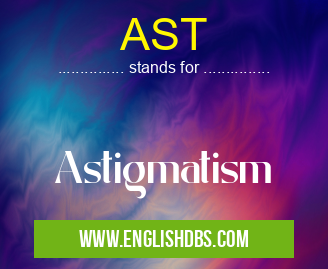What does AST mean in PHYSIOLOGY
Astigmatism is a common type of vision impairment that occurs when the shape of the cornea is curved incorrectly. It's caused by a disruption in the regular curvature of the cornea, which affects how light rays enter your eye and affects your vision. Astigmatism, abbreviated ‘AST', can cause blurred and distorted vision.

AST meaning in Physiology in Medical
AST mostly used in an acronym Physiology in Category Medical that means Astigmatism
Shorthand: AST,
Full Form: Astigmatism
For more information of "Astigmatism", see the section below.
» Medical » Physiology
Symptoms
The most common symptom of astigmatism is blurred vision, which can range from mild to severe depending on the degree of astigmatism an individual has. Some people may experience headaches or eyestrain due to trying to focus their eyes on close objects more than usual. They may also experience double vision or ghosting when looking at distant objects.
Treatment
If you have been diagnosed with AST, there are several treatment options available to improve your vision. Corrective lenses such as glasses or contact lenses are often recommended to reduce any blurriness. Refractive surgery may also be an option for some individuals who don't respond well to corrective lenses or wish to correct their vision permanently. This procedure involves reshaping the cornea so that light can properly enter your eye again and improve your vision.
Essential Questions and Answers on Astigmatism in "MEDICAL»PHYSIOLOGY"
What is astigmatism?
Astigmatism is a common eye condition that causes blurred vision due to an irregularly shaped cornea. When the cornea is curved, it prevents light from focusing properly on the retina, resulting in distorted or blurred vision.
Are there different types of astigmatism?
Yes, there are two main types of astigmatism - Myopic Astigmatism (or nearsightedness) and Hyperopic Astigmatism (or farsightedness). Depending on the severity of the condition, one type may be more prevalent than the other.
Who can be affected by astigmatism?
Anyone can develop astigmatism at any age - although it usually begins during early childhood and continues throughout adulthood. It is also possible to be born with astigmatism.
What are the symptoms of astigmatism?
The most common symptom of astigmatism is blurry vision both up close and from a distance. Other symptoms may include headaches, eyestrain, difficulty reading for prolonged periods of time, or squinting.
What are some common treatments for astigmatism?
Common treatments for astigmatism include prescription lenses such as corrective eyeglasses or contact lenses, laser eye surgery, orthokeratology (a special type of soft contact lens), refractive surgery (such as LASIK) or corneal relaxing incisions (for mild cases).
Are there any risks associated with astigmatic correction surgeries?
Yes, like any surgical procedure there are certain risks associated with corrective surgeries for treating astigmatisms such as increased dry eye symptoms, infection or inflammation and light sensitivity. Always consult your ophthalmologist before undergoing any surgery related to your eyes.
Are there any exercises I can do to help reduce myastigmatic symptoms? A: Certain kinds of exercise can help improve your visual health if you have an astigmatic condition. These include activities designed to strengthen the muscles around your eyes—what's known as “oculomotor exercisesâ€â€”as well as blinking exercises which also help lubricate your eyes and provide relief from digital eye strain. Additionally, Yoga has been found to provide relief from some of the physical symptoms associatedwithastigmatismsuchasyesstrain ordifficultyreadingforprolongedperiodsoftime.[END] Q: Is it possible for myastigmatic conditin to worsen over time?
Certain kinds of exercise can help improve your visual health if you have an astigmatic condition. These include activities designed to strengthen the muscles around your eyes—what's known as “oculomotor exercisesâ€â€”as well as blinking exercises which also help lubricate your eyes and provide relief from digital eye strain. Additionally, Yoga has been found to provide relief from some of the physical symptoms associatedwithastigmatismsuchasyesstrain ordifficultyreadingforprolongedperiodsoftime.
Final Words:
Astigmatism (abbreviated AST) is a common optical condition that affects how light enters into the eye and can cause distorted and blurred vision. There are several treatment options available for those who have been diagnosed with AST such as glasses or contact lenses, or even refractive surgery if needed. Regardless of which treatment you choose, it's important to speak with your eye care professional and get regular checkups in order to ensure proper care for any type of vision impairment.
AST also stands for: |
|
| All stands for AST |
